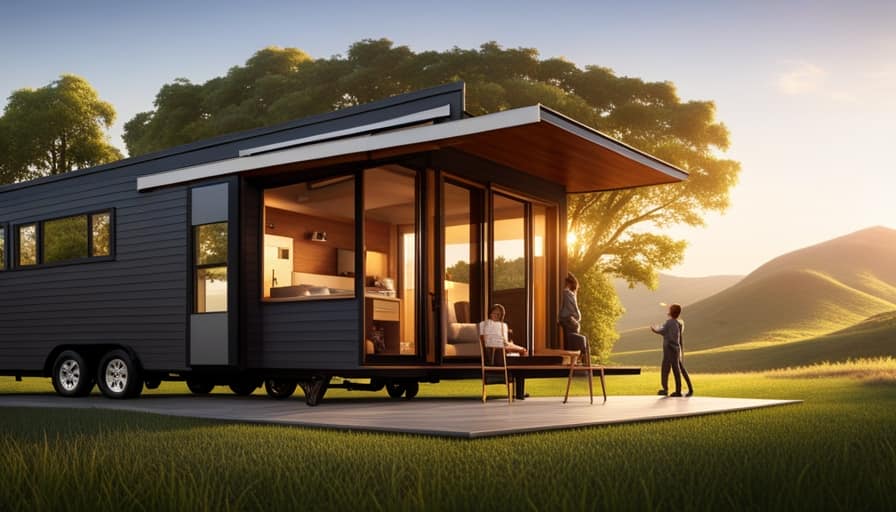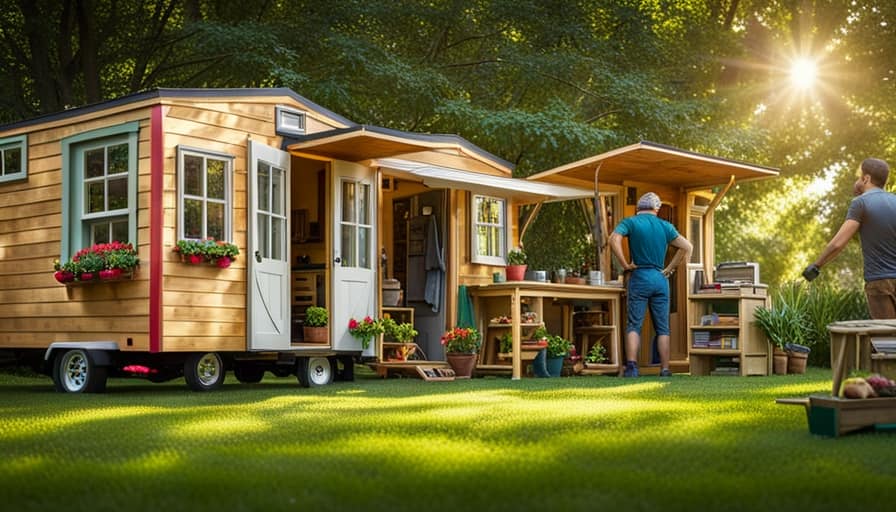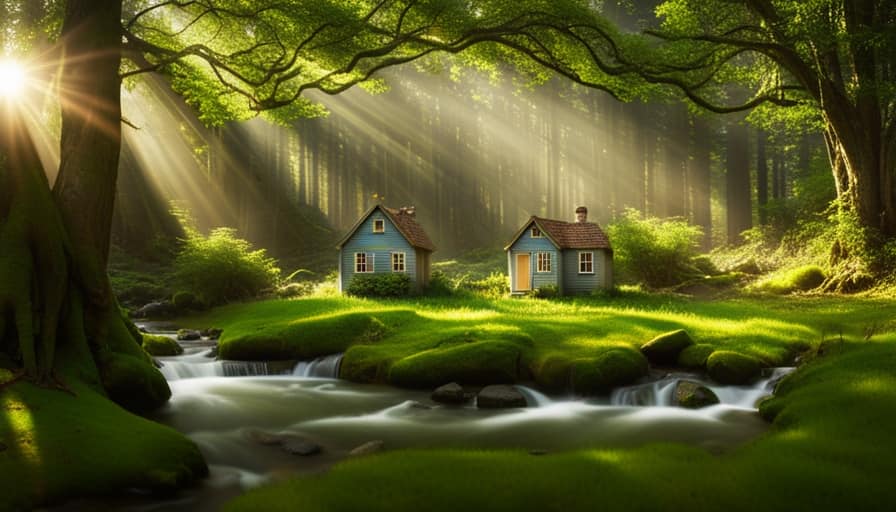Welcome to our guide to the top 10 urban sanctuaries for tiny house living! Get ready to embark on a journey through hidden gems that will captivate your heart and soul.
We’ll take you to sustainable havens that embrace nature in the concrete jungle, converted warehouses bursting with industrial chic charm, and cozy cottages nestled in the heart of the city.
Discover the beauty of tiny house communities by the seaside and rooftop retreats with sky-high views. Join us as we explore these small wonders and find your perfect urban sanctuary.
Key Takeaways
- The Eco Oasis: Innovative design, eco-conscious living principles, reduction of carbon footprint, incorporation of renewable energy sources, integration of green spaces, contribution to the greater good of the planet
- Industrial Chic: Increasing popularity of industrial renovation and warehouse conversion, unique appeal of raw, industrial elements combined with cozy tiny house living, spaciousness and high ceilings of warehouses as a canvas for stylish living spaces, exposed brick walls adding character and warmth, large windows allowing for plenty of natural light
- Backyard Bliss: Tranquil oasis amidst the urban hustle and bustle, lush greenery, blooming flowers, and soothing water features creating a serene environment, private escape from the outside world, convenient access to amenities while still having a peaceful retreat, perfect for relaxation and rejuvenation
- Rooftop Retreat: Untapped potential of rooftops for tiny house living, breathtaking views and sense of freedom, utilization of vertical space in urban areas, contribution to rooftop farming and urban sustainability, sky-high views offering a peaceful escape from urban life
The Eco Oasis: A Sustainable Haven for Tiny House Dwellers
Our Eco Oasis is a sustainable haven for us tiny house dwellers. With its innovative design and eco-conscious living principles, our community is committed to reducing our carbon footprint while creating a harmonious environment.
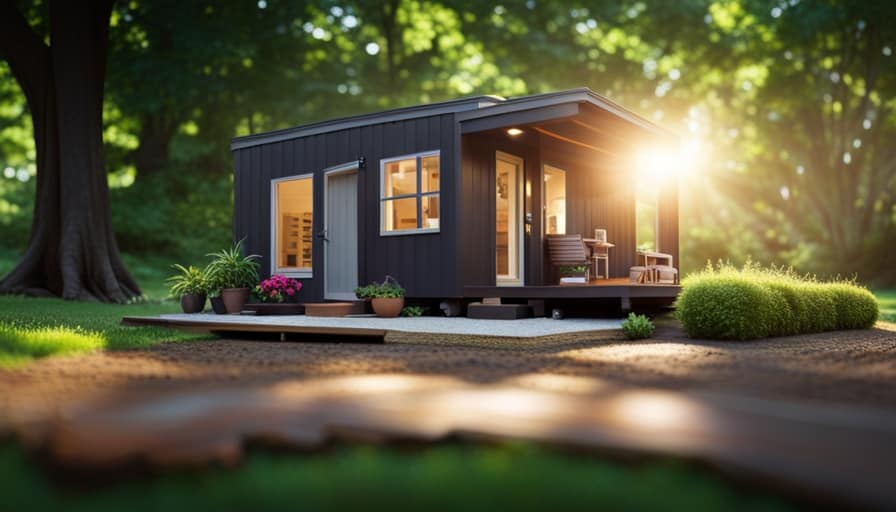
Every aspect of the Eco Oasis has been carefully considered to promote sustainability. From the use of renewable energy sources to the incorporation of green spaces, our community is a shining example of sustainable design.
We believe in living in harmony with nature, and our Eco Oasis provides the perfect platform for us to do so. By embracing eco-conscious living, we not only benefit ourselves but also contribute to the greater good of the planet.
As we explore the charm of converted warehouses in the next section, we invite you to join us on this incredible journey towards sustainable living.
Industrial Chic: Discover the Charm of Converted Warehouses
Let’s explore the unique appeal of converted warehouses and discover the industrial chic they offer for tiny house living. Industrial renovation and urban warehouse conversion have become increasingly popular in the world of tiny house enthusiasts. There is something undeniably charming about the combination of raw, industrial elements and the coziness of a tiny house. The spaciousness and high ceilings of warehouses provide a perfect canvas for creating a stylish and functional living space. With exposed brick walls, concrete floors, and large windows, these converted warehouses offer a unique blend of rustic charm and contemporary design. They allow for creative customization and provide ample space for storage and personalization. Take a look at the table below to see some of the key features and benefits of living in a converted warehouse:

| Key Features | Benefits |
|---|---|
| Exposed brick walls | Adds character and warmth |
| High ceilings | Creates a sense of spaciousness |
| Large windows | Allows for plenty of natural light |
If you’re seeking an alternative and stylish living option, consider the industrial chic of converted warehouses for your tiny house journey.
Backyard Bliss: Cozy Cottages in the Heart of the City
We adore the charm and tranquility of cozy cottages nestled in the heart of the city. These backyard retreats offer a peaceful oasis amidst the hustle and bustle of urban life. Here are three reasons why we believe these city gardens are the ultimate blissful escape:
-
Serene Sanctuaries: With their lush greenery, blooming flowers, and soothing water features, these city gardens create a serene environment where you can unwind and recharge. The beauty of nature surrounds you, providing a sense of calm and tranquility.
-
Private Paradise: These cozy cottages offer a private escape from the outside world. Whether you want to curl up with a good book in a hammock or enjoy a cup of tea on a sun-drenched patio, these backyard retreats provide a peaceful haven where you can relax and rejuvenate.

-
Convenient Connection: Living in the heart of the city doesn’t mean sacrificing access to amenities. These cozy cottages offer the best of both worlds – a private oasis just steps away from restaurants, shops, and cultural attractions. You can enjoy the vibrancy of urban living while still having a tranquil retreat to call home.
Indulge in the pleasure of backyard bliss with these cozy cottages in the heart of the city. Experience the beauty of a city garden and create your own private sanctuary.
Rooftop Retreat: Tiny Living With a Sky-High View
When it comes to urban living, rooftops offer a world of untapped potential. Imagine the breathtaking views, the fresh air, and the sense of freedom that comes with living high above the city streets.
With tiny houses, we’ve the unique advantage of taking advantage of this altitude. Rooftop retreats not only provide a sky-high view, but they also offer a sanctuary in the midst of the bustling city, allowing us to escape the chaos and find solace in our own little piece of the sky.
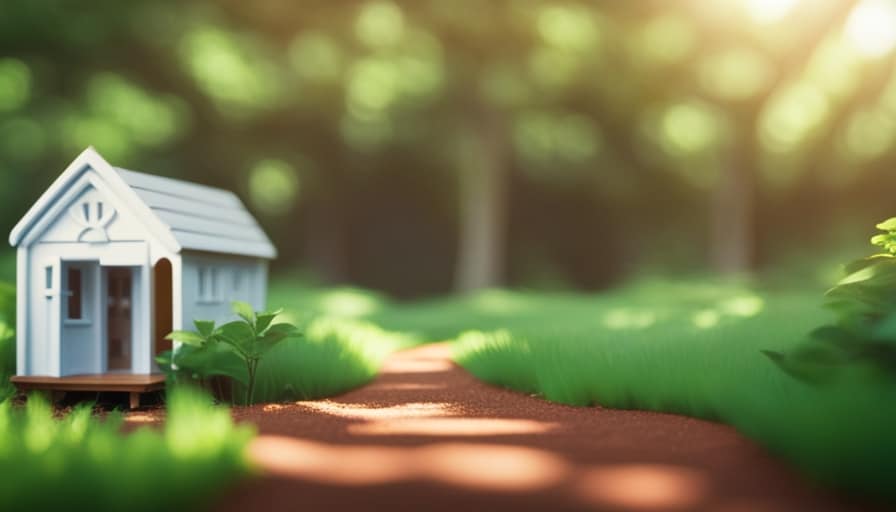
Urban Rooftop Potential
Living in a tiny house with an urban rooftop retreat offers us a sky-high view and an incredible sense of tranquility. The potential of utilizing rooftops in urban areas for tiny house living isn’t only exciting but also contributes to rooftop farming and urban sustainability.
Here are three reasons why urban rooftop living is a game-changer:
-
Maximizing space: With limited land availability in urban areas, rooftop living allows us to make the most of the vertical space. It provides an opportunity to create a cozy and sustainable living environment while utilizing previously unused areas.
-
Sustainable living: By incorporating rooftop farming into our tiny house retreats, we can contribute to urban sustainability. Rooftop gardens not only provide fresh produce but also help reduce the heat island effect, improve air quality, and promote biodiversity.
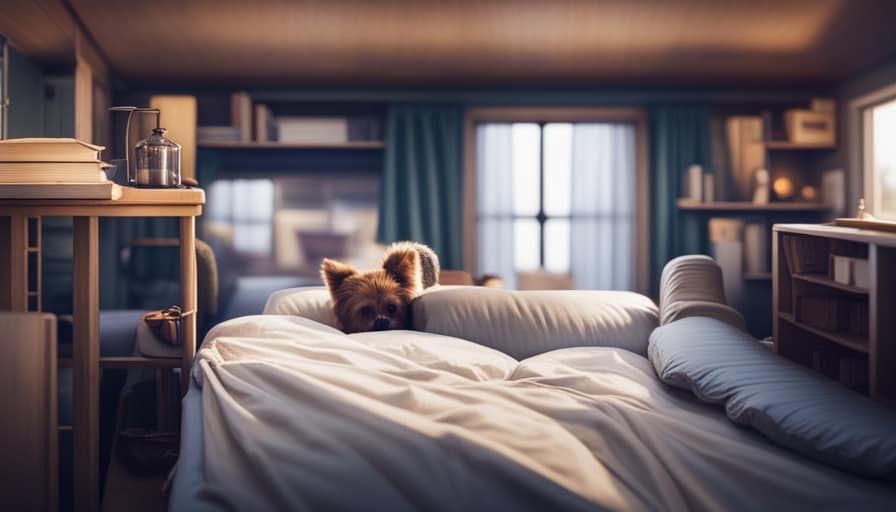
-
Sky-high views: Imagine waking up to breathtaking sunrises and enjoying stunning cityscape views from your rooftop retreat. The sense of serenity and connection with nature that comes with these views can be truly transformative, offering a peaceful escape from the hustle and bustle of urban life.
Embracing the potential of urban rooftops for tiny house living not only enhances our quality of life but also allows us to contribute to a more sustainable and vibrant urban ecosystem. Let’s explore the possibilities and create an urban sanctuary that serves both ourselves and the community.
Tiny House Altitude Advantage?
With its breathtaking vistas and endless possibilities, a rooftop retreat offers us an altitude advantage in tiny house living. Imagine waking up to the stunning view of the city skyline or the peaceful serenity of the surrounding nature. Living on the rooftop not only provides a unique perspective, but it also maximizes the limited space of a tiny house.
By utilizing the vertical space, we can create multi-level living areas, allowing for separate zones for sleeping, working, and entertaining. The elevated position also offers benefits like increased privacy, better ventilation, and natural light.
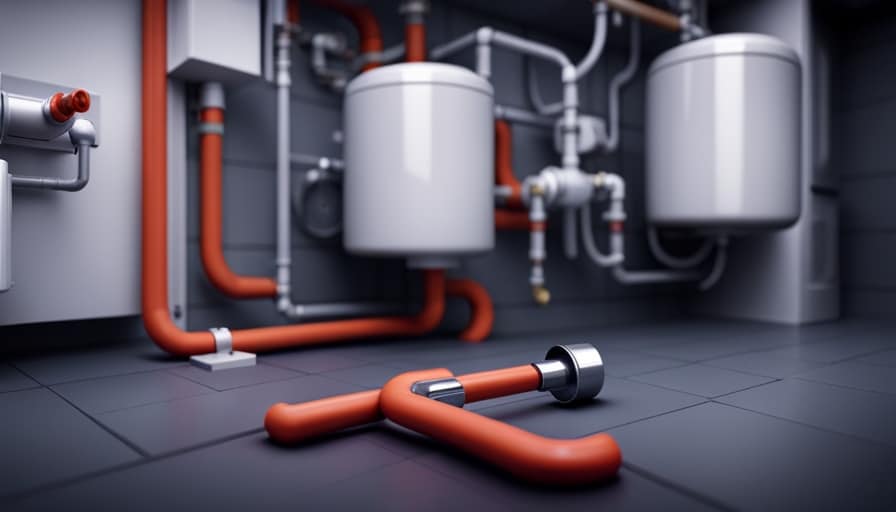
Furthermore, a rooftop retreat provides an opportunity to create a green oasis in the concrete jungle. We can transform the rooftop into a garden, growing our own food and enjoying the therapeutic benefits of nature.
With all these elevated living advantages, a rooftop retreat truly takes tiny house living to new heights.
Seaside Serenity: Coastal Tiny House Communities
We have discovered several breathtaking coastal tiny house communities that offer a serene and idyllic seaside living experience. Living by the coast in a tiny house allows you to fully immerse yourself in the beauty of nature while enjoying the benefits of a minimalist lifestyle. Here are three reasons why coastal tiny house communities are the perfect choice for those seeking seaside serenity:
-
Unparalleled Views:
Imagine waking up each morning to the sound of crashing waves and the sight of the sun rising over the horizon. Coastal tiny house designs often feature large windows and outdoor living spaces, allowing you to take full advantage of the stunning ocean views.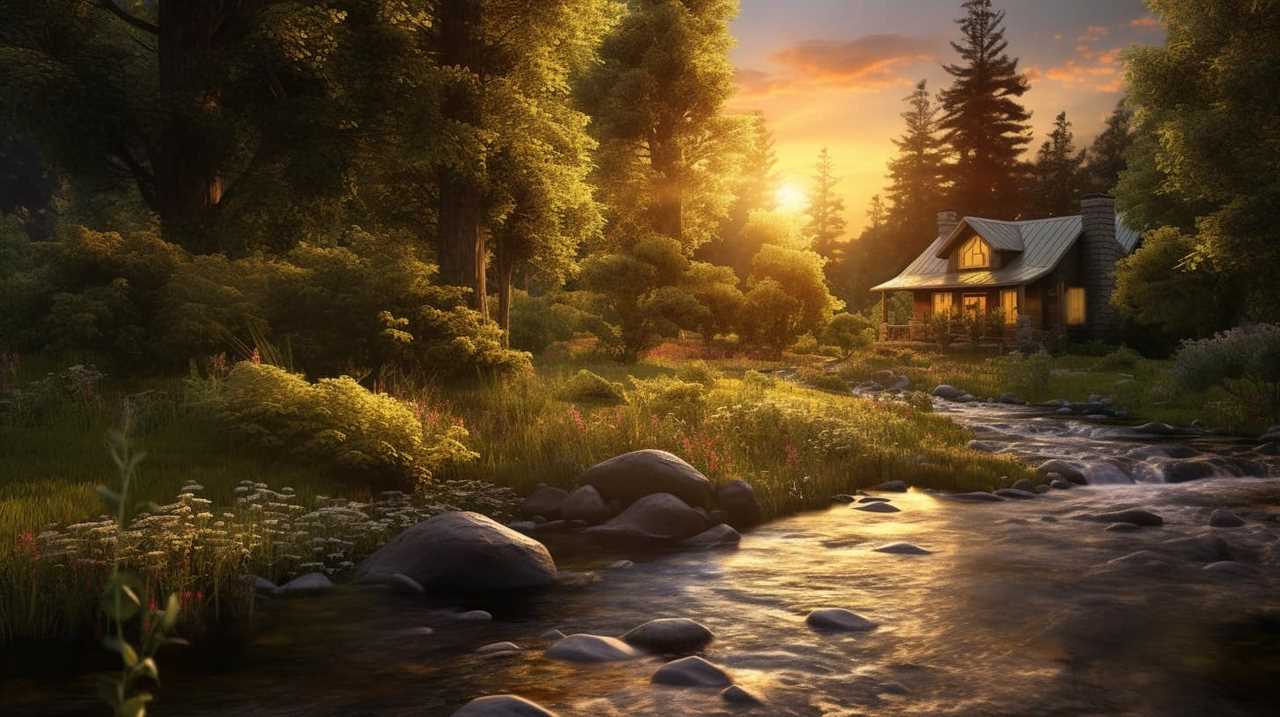
-
Beachside Activities:
From swimming and surfing to beachcombing and fishing, coastal living offers a wide range of outdoor activities. Living in a tiny house community by the sea means you can easily access these activities and make the most of your coastal lifestyle. -
Peace and Tranquility:
There’s something incredibly calming about being near the ocean. The sound of the waves, the salty sea breeze, and the vast expanse of water create a sense of peace and tranquility that’s hard to find elsewhere. Coastal tiny house communities provide a perfect escape from the hustle and bustle of city life.
Hidden Gems: Off-the-beaten-path Tiny House Enclaves
Hidden gems, off-the-beaten-path tiny house enclaves, are waiting to be discovered by adventurous souls seeking serene escapes from the crowds. These unexplored havens offer a chance to disconnect from the noise and reconnect with nature, allowing us to truly appreciate the simplicity and beauty of tiny house living.
Whether nestled in the mountains, hidden in the woods, or tucked away by a tranquil lake, these hidden gems provide a sense of peace and tranquility that’s hard to find in bustling urban areas.
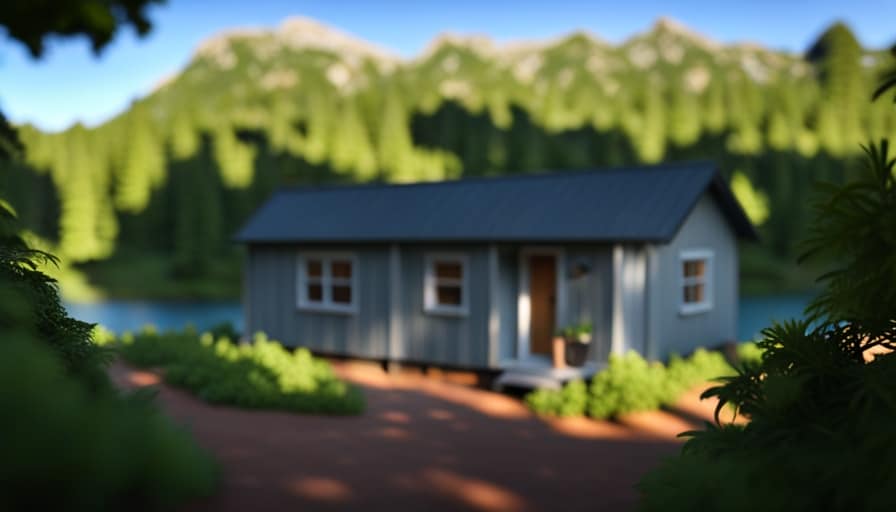
Unexplored Tiny House Havens
One of our favorite unexplored tiny house havens is tucked away in the peaceful mountains of Colorado. This hidden gem offers a serene escape from the bustling city life, allowing you to reconnect with nature and find solace in simplicity.
Here are three reasons why this unexplored tiny house destination should be at the top of your list:
-
Breathtaking Scenery: Imagine waking up to panoramic views of snow-capped mountains and lush green valleys. This tiny house enclave offers unparalleled beauty that will leave you in awe.
-
Tranquil Atmosphere: Away from the noise and chaos of urban living, this hidden treasure provides a tranquil sanctuary where you can unwind and rejuvenate your mind, body, and soul.

-
Outdoor Adventures: Whether it’s hiking, biking, or fishing, this unexplored tiny house haven offers a plethora of outdoor activities to satisfy your adventurous spirit.
As we explore these uncharted tiny house havens, let’s now venture into the next section to discover serene escapes from crowds.
Serene Escapes From Crowds
What are some off-the-beaten-path tiny house enclaves that offer serene escapes from crowds?
If you desire to retreat from the chaos and find solace in serene nature, there are hidden gems waiting to be discovered. These peaceful havens provide the perfect sanctuary for those seeking peaceful solitude.
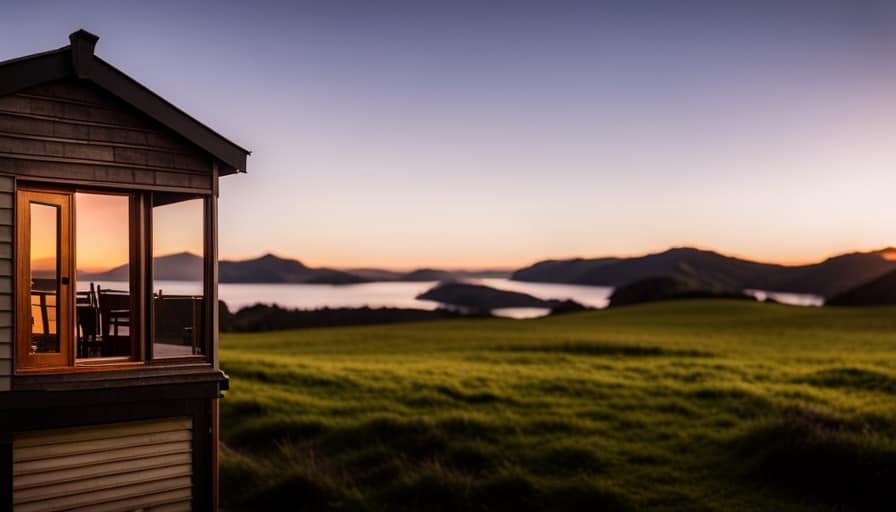
One such enclave is nestled deep within the majestic mountains, where the air is crisp and the views are breathtaking. Here, you can wake up to the sound of birds chirping and feel the gentle breeze rustling through the trees. Surrounded by towering pines and babbling brooks, you can immerse yourself in the tranquility of nature.
Another hidden gem lies by the serene shores of a secluded lake. Imagine waking up to the gentle lapping of water against the shore, with the sun peeking through the trees. You can spend your days kayaking, fishing, or simply lounging by the water’s edge, soaking in the peaceful ambiance.
These off-the-beaten-path enclaves offer a unique opportunity to escape the crowds and find solace in the beauty of nature. Whether you crave the serenity of the mountains or the tranquility of the lake, these hidden gems will provide the perfect respite from the hustle and bustle of everyday life. So, pack your bags and embark on a journey to these serene escapes. Your soul will thank you for it.
Urban Farmsteads: Embrace Nature in the Concrete Jungle
We love the idea of creating urban farmsteads in the concrete jungle, where we can embrace nature and cultivate our own food. Urban farming provides a sustainable way of living, allowing us to reduce our carbon footprint and have a direct impact on our environment.

Here are three reasons why urban farmsteads are a fantastic option for those who desire serving others:
-
Food Security: By growing our own food, we can ensure that we’ve access to fresh, nutritious produce. This not only improves our health but also reduces our reliance on long-distance transportation and industrial farming practices.
-
Community Building: Urban farmsteads bring people together, fostering a sense of camaraderie and connection. Through shared gardens and farm-to-table initiatives, we can create a vibrant and supportive community that values sustainability and self-sufficiency.
-
Educational Opportunities: Urban farming provides a unique learning experience for both adults and children. It allows us to reconnect with nature, learn about sustainable practices, and develop important skills such as gardening and composting.
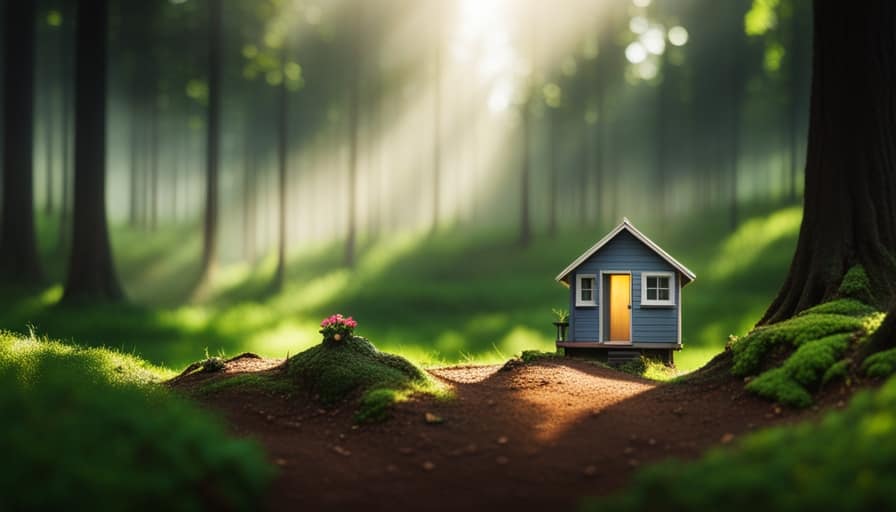
By embracing urban farmsteads, we can create a greener, healthier, and more vibrant concrete jungle.
But let’s not forget about the historical havens of tiny houses in historic neighborhoods, where we can find solace in the past while embracing a sustainable future.
Historical Havens: Tiny Houses in Historic Neighborhoods
Let’s explore the charm and character of tiny houses nestled in historic neighborhoods, where we can truly appreciate the rich history and architectural beauty. These historical havens offer a unique opportunity to live in a tiny house while immersing ourselves in a community that values historic preservation and architectural significance.
Living in a tiny house in a historic neighborhood allows us to become part of a larger story. We can walk the same streets that generations before us have walked, and admire the well-preserved buildings that hold so much history within their walls. Each tiny house in these neighborhoods becomes a testament to the past, blending seamlessly with the existing architectural fabric.
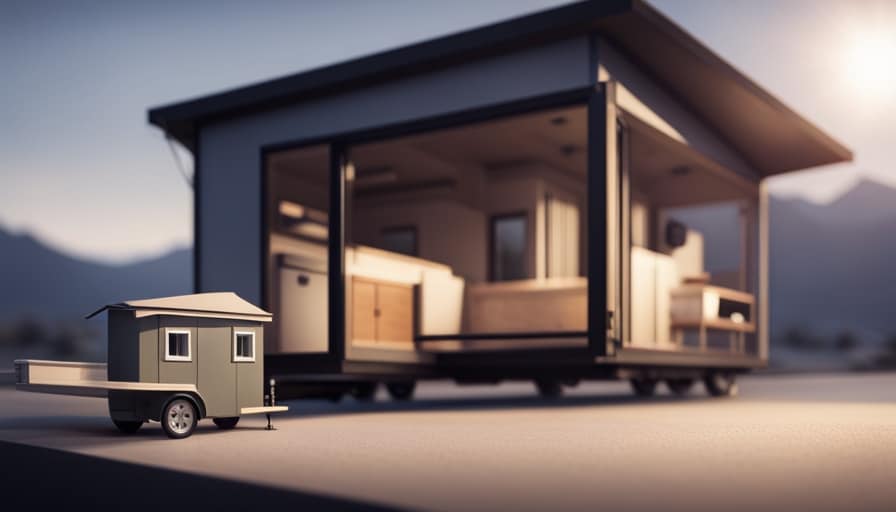
Artistic Abodes: Celebrating Creativity in Tiny Homes
We can find inspiration and express our creativity by immersing ourselves in the artistic abodes of tiny homes. These tiny houses aren’t just functional living spaces, but also works of art that celebrate unique designs and showcase the creativity of their owners.
The tiny house movement has given rise to a new form of artistry, where every square inch of space is carefully crafted to reflect the owner’s personality and style. From vibrant murals and hand-painted furniture to innovative storage solutions and upcycled materials, tiny homes offer a canvas for creative interior decor.
The role of art in small spaces goes beyond aesthetics; it nurtures creativity and allows individuals to think outside the box. Celebrating tiny house artistry is a way to inspire others to embrace their own creativity and create spaces that truly reflect who they are.
Community Connection: Thriving Tiny House Villages
The article explores the thriving tiny house villages that foster a strong sense of community and connection among residents. These villages are more than just a collection of tiny homes, they’re vibrant communities where individuals come together to support and uplift one another.
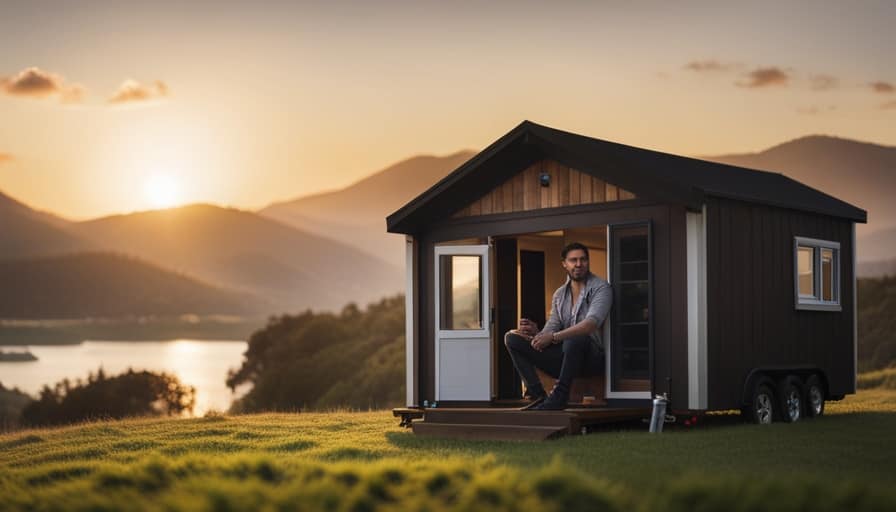
In these villages, residents share resources, ideas, and experiences, creating a thriving community that’s greater than the sum of its parts. The shared resources in these tiny house villages allow residents to live more sustainable and efficient lives. From communal gardens to shared laundry facilities, these villages are designed to promote a sense of togetherness and collaboration.
Living in a tiny house village not only offers the opportunity to simplify and downsize, but also provides a platform for individuals to connect and serve others in a meaningful way.
Frequently Asked Questions
Are There Any Financial Incentives or Tax Breaks Available for Living in a Tiny House?
Yes, there are financial incentives and tax breaks available for living in a tiny house. These incentives can help alleviate the financial burden and make tiny house living a more affordable and sustainable option for many.
What Are the Zoning Regulations and Legal Requirements for Parking and Living in a Tiny House in Urban Areas?
Zoning regulations, parking requirements, and legal considerations are important factors to consider when living in a tiny house in urban areas. It’s crucial to adhere to size and design restrictions while also managing utilities and sewage disposal. Additionally, exploring shared amenities and community spaces can enhance the tiny house living experience. Financial incentives and tax breaks may be available, so it’s worth researching potential benefits.
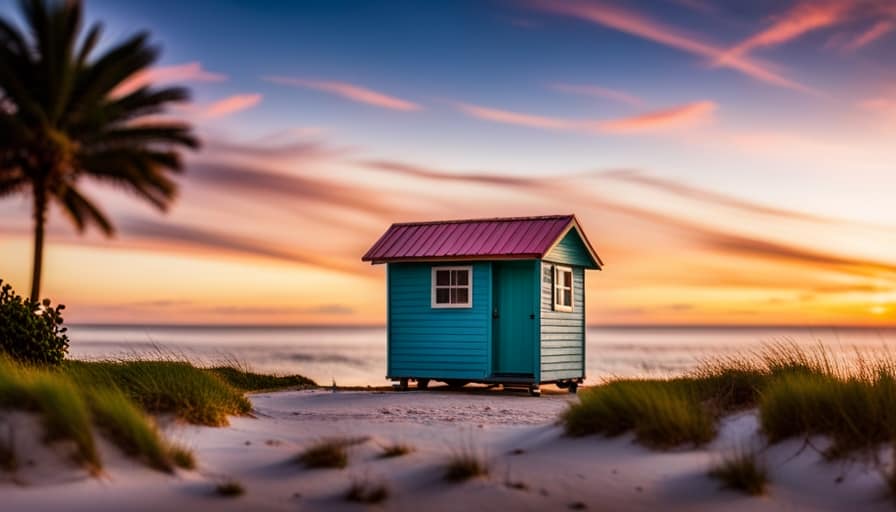
How Do Tiny House Communities Handle Utilities Such as Water, Electricity, and Sewage?
In tiny house communities, we have found innovative off-grid options for utilities like water and electricity. Additionally, we are passionate about waste management and have implemented creative solutions for sewage in urban areas.
Are There Any Restrictions on the Size or Design of Tiny Houses in the Featured Urban Sanctuaries?
There are size and design restrictions for tiny houses in the featured urban sanctuaries. However, these limitations are in place to ensure the safety and harmony of the community, allowing for a sustainable and enjoyable living experience.
Do These Urban Sanctuaries Offer Any Amenities or Shared Spaces for Their Residents?
Shared facilities and community activities are important aspects of urban sanctuaries for tiny house living. These spaces provide opportunities for residents to come together, share resources, and foster a sense of belonging and support.
Conclusion
In conclusion, these urban sanctuaries offer a breath of fresh air for those seeking a simpler, more sustainable way of life. They symbolize a rebellion against the confines of the modern world, embracing creativity, community, and connection with nature.

With their charm and character, these tiny house havens beckon us to step out of the chaos and into a world where less is truly more. Join the movement and find your own slice of paradise in these urban oases.
I’m Theodore, and I love tiny houses. In fact, I’m the author of Tiny House 43, a book about tiny houses that are also tree houses. I think they’re magical places where imaginations can run wild and adventures are just waiting to happen.
While tree houses are often associated with childhood, they can be the perfect adult retreat. They offer a cozy space to relax and unwind, surrounded by nature. And since they’re typically built on stilts or raised platforms, they offer stunning views that traditional homes simply can’t match.
If you’re looking for a unique and romantic getaway, a tree house tiny house might just be the perfect option.
